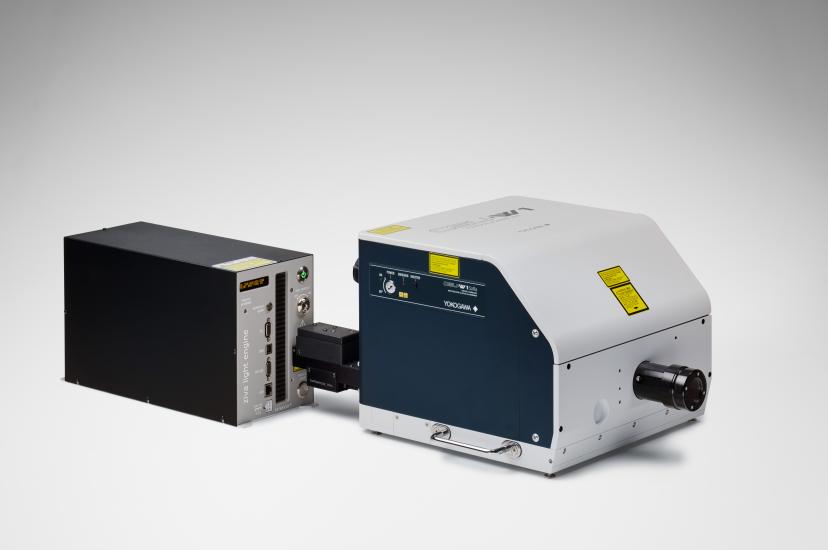The latest Neurophotonics products in 2025

Neurophotonics is a relatively new way of studying the brain that uses light-based technologies to help scientists see and understand how the nervous system works (Credit: Andrii Vodolazhskyi/Shutterstock.com)
Neurophotonics is a relatively new way of studying the brain that uses light-based technologies to help scientists see and understand how the nervous system works. Imagine being able to look inside the brain and watch individual brain cells communicate with each other - that's what researchers in this field can do.
What is neurophotonics?
At its simplest, neurophotonics combines tools from different scientific areas, such as neuroscience, physics, and engineering. Scientists use special microscopes and light techniques to watch brain activity in ways that weren't possible before. They can now see how brain cells talk to each other, map out brain connections, and even trigger specific brain responses using carefully controlled light.
What are the core technologies used in neurophotonics?
Neurophotonics uses advanced optical imaging techniques, such as two-photon microscopy, optogenetics, fluorescence imaging, and light-based neural stimulation methods to enable precise observation and manipulation of neural circuits with minimal invasiveness. This enables advanced research applications such as studying neural communication and signaling, mapping brain connectivity and investigating neurological disorders. It can also lead to potential therapeutic interventions, exploring neural plasticity and learning mechanisms.

ZIVA Light Engine for Yokogawa CSU
The Yokogawa CSU is a highly regarded spinning disk confocal scanner in widespread use for 3-dimensional imaging of live cells, tissues, and microorganisms. The range of fluorescence excitation wavelengths provided by lighting installed on CSU systems is often limited to four lasers. Lumencor’s ZIVA Light Engine increases the number of lasers from four to seven at a price well below that of the CSU scanner.
The ZIVA’s lasers are refined by bandpass filters, merged into a common optical train, passed through a despeckler, and directed to the light output port on the front panel. Output wavelength is selected by direct on/off switching of the lasers. The Light Engine output is directed to the Yokogawa CSU scanner through a precision-engineered adapter. This optical coupler provides intense and uniform illumination at the sample plane. All these capabilities are assembled in a compact, bench-top device with a 15 cm x 35 cm footprint.
SPONSORED BY

What are the opportunities and challenges of neurophotonics?
Neurophotonics opens up possibilities for understanding and treating neurological conditions by using advanced light-based technologies to observe brain activity with greater precision. Researchers can now visualise individual neural connections, track brain processes in real-time, and develop innovative therapeutic approaches for complex disorders like Parkinson's, epilepsy, and depression. The field could provide transformative medical interventions, including sophisticated brain-machine interfaces that could help individuals with neurological disabilities, potentially allowing more direct communication between the brain and external devices. By enabling scientists to see and potentially manipulate neural circuits at microscopic scales, neurophotonics offers hope for breakthrough treatments and a deeper understanding of how the human brain functions.
Despite its potential, neurophotonics faces some obstacles. The technical complexity of observing delicate brain tissue without causing damage requires ever more sophisticated and expensive technologies. Biological limitations mean that introducing light-based tools into living neural systems could risk unintended consequences, and interpreting the vast amount of data generated is also challenging. Additionally, the field demands a high degree of collaboration across multiple scientific disciplines, each with its own specialised language and approach, making interdisciplinary communication and progress inherently difficult.
Regardless of these challenges, the potential of neurophotonics is exciting. As technologies and products evolve and interdisciplinary collaboration increases, there could be significant breakthroughs in understanding brain function, treating neurological disorders, and developing innovative neural technologies.
Neurophotonics products on the market now
Vendors of neurophotonics products and solutions include Artinis Medical Systems, which offers functional near infrared spectroscopy (fNIRS) instruments for brain imaging. The functional component comes from the fact that the fNIRS devices are capable of assessing brain activity by measuring changes in oxyhemoglobin and deoxyhemoglobin, which reflect local brain activity. Moreover, fNIRS provides a non-invasive manner to achieve an excellent resolution brain signal in real time.
Advanced Micro Foundry (AMF) specialises in customisable prototyping and manufacturing services for silicon photonics integrated circuits. Its technology has been used in many applications, including research and academia for prototyping of probes to record brain activity, amongst other use cases.
Bruker offers high-field preclinical and molecular imaging systems for obtaining high-resolution visualisations of the brain, including MRI scanners specifically designed for in vivo rodent imaging, such as the Biospec 15.2 T scanner. Neuroscientists can also benefit from the company’s Positron Emission Tomography (PET) systems to obtain metabolic information. For example, PET can be used to detect changes in brain metabolic activity and receptor densities.
Cairn Research is an independent scientific instrument manufacturer. It designs and builds equipment for optical and electrophysiological measurements. In addition to its standard product range, integrated solutions can also be produced for demanding experimental needs. The company has a range of equipment for Neurophotonics applications.
Cobolt offers a series of laser assemblies specifically tailored for advanced optogenetics research. Solutions include single-line lasers with stable and efficient coupling into multi mode fibres, two lasers on a common platform launched into one common fibre coupler, or two lasers sitting side by side launched into one fibre coupler each, suitable for 2-into-1 coupling using, for example, fused fibres.
Edmund Optics can provide a range of optics to enable fluorescence imaging. Fluorescence microscopy can be used to detect ailments of the brain more quickly so that they can be treated. The company’s finite conjugate objectives, for example, are microscope objectives that do not require a secondary lens to focus onto a specimen. They are typically optimised for use in the visible spectrum and contain up to four lens elements.
The Femto3D Atlas microscope from Femtonics is used in twophoton microscopy applications, allowing neuroscientists to reach the deep regions of the brain (down to 850µm) and study them at a high spatiotemporal resolution. The microscope enables the precise spatial and real-time complexity of neuronal coding in a neural network to be resolved by scanning a large number of cells distributed in a near cubic millimetre 3D volume.
Hamamatsu’s range of brain and tissue oxygen monitors can continuously and noninvasively measure oxygenation in the brain or other tissue in the body. Applications range from monitoring tissue oxygenation during surgery to clinical studies on brain functions.
Leica Microsystems offers microscope solutions to support neurosurgeons in complex microsurgery applications. The microscopes provide optimal and reliable visualisation, including built-in fluorescence filters and GLOW 800 augmented reality fluorescence. This and ICG create a simultaneous white-light and real-time fluorescent blood flow view.
Lumencor’s solid-state light engines house light sources that offer controllable output on the millisecond level, the same timescale as nerve impulse occurrences. The products comply with the primary spectral output requirement to have maximal overlap integral of the light engine spectral output with the action spectra of photoactivatable ion channel proteins (475 nm for stimulation with channelrhodopsin and 575 nm for inhibition with halorhodopsin). This has led to the products being used in numerous optogenetics light delivery projects for neuroscience and other applications.
MKS Instruments recently expanded its Spectra-Physics InSight X3+ tunable ultrafast lasers with the introduction of an integrated attenuation option. This new capability provides on-board, software-controlled adjustment of the output power to augment the built-in automated wavelength and dispersion compensation tuning for added optimisation of multiphoton imaging performance. InSight lasers offer 680 to 1300nm wavelength tuning range, and every InSight laser includes DeepSee automated dispersion compensation to ensure the shortest pulses are delivered to the sample. They are used in a number of bio-imaging and neurophotonics applications.
Wavelength Electronics’s LDD400P series 400 mA laser diode drivers are widely used in laser spectroscopy, electro-optical systems, biomedical research and neurophotonic applications. The low noise drivers offer high stability in constant current mode. They can precisely control the laser diode current with the on-board output current adjust trimpot, or via a remote voltage to the modulation input. They can also adjust the limit current trimpot to protect the laser diode from exceeding its maximum current rating, even when modulating the laser diode.
Zeiss International offers a number of products for neuroscience applications, such as the Axio Examiner fixed-stage microscope, suited to electrophysiology studies. For imaging of whole brain sections, the Axio Scan.Z1 is an integrated solution. Meanwhile, closer neuroscience research investigations of fluorescently labelled neuronal spines are possible using super-resolution microscopy methods, such as structured illumination microscopy (SR-SIM). The company’s ELYRA S.1 provides twice the resolving power of a conventional light microscope by using any conventional fluorophore and Z-sectioning for 3D data acquisition.
This is not an exhaustive list. If you want your company included in our roundup, please email: editor.electro@europascience.com

